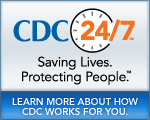MMWR
Morbidity and Mortality Weekly Report
MMWR News Synopsis for October 11, 2007
- World Arthritis Day — October 12, 2007
- State-Specific Prevalence of Arthritis–Attributable Work Limitation — United States, 2003
- Deaths from Intravenous Colchicine Attributed to a Compounding Pharmacy Error — Oregon and Washington, 2007
- HIV/AIDS Among Hispanics — United States, 2001a€“2005
There will be no MMWR telebriefing scheduled for:
October 11, 2007
World Arthritis Day — October 12, 2007
PRESS CONTACT: CDC Division of Media Relations
(404) 639–3286
No summary available.
State–Specific Prevalence of Arthritis–Attributable Work Limitation — United States, 2003
PRESS CONTACT: CDC Division of Media Relations
(404) 639–3286
Addressing work limitation due to arthritis through greater use of effective and available interventions should help reduce the high impact that arthritis can have on work in all U.S. states and can also decrease the personal, societal, and financial impacts of arthritis. In all states, US working–age (18–64 years old) adults face work limitations that they attribute to arthritis. The prevalence of work limitations due to arthritis among all working age adults in the nation varied from state–to–state but was generally high, ranging from 3.4 percent to 15 percent. The proportion of working–age adults with arthritis who also had arthritis–attributable work limitations ranged from 25.1 percent to 51.3 percent. In all states, people with work limitations due to arthritis were less likely to be employed than both those who had arthritis without work limitations and all working–age adults in the state. These are the first state–specific prevalence estimates of the impact of work limitations due to arthritis. Examining this impact is important as arthritis is projected to increase with the aging of the population, and Americans are staying in the workforce longer. Anticipating and accommodating persons with work limitations due to arthritis makes simple social and economic sense. The increased use of effective interventions among those with arthritis can help people with arthritis enter and stay in the workforce and should be a national priority.
Deaths from Intravenous Colchicine Attributed to a Compounding Pharmacy Error — Oregon and Washington, 2007
PRESS CONTACT: Dr. Zane Horowitz, Medical Director
Oregon Poison Center
(503) 494–4833
Medications obtained from compounding pharmacies may not be subjected to the same level of regulatory scrutiny as pharmaceutical manufacturers. Buying such medications over the internet has substantial risks. This report describes the investigation into the deaths of three patients who received IV colchicine from an alternative medicine clinic in Oregon as treatment for back pain. The investigation indicated a measuring error by a compounding pharmacy led to a fatal colchicine concentration that was eight times greater than the reported level on the label. Seventy remaining vials of colchicine were confiscated from the clinic and all colchicine that had been sold or produced by the compounding pharmacy within the last year was recalled. No additional deaths have been reported. These cases highlight the risk from inappropriate use of IV colchicine for back pain. The early and coordinated public health response to these drug–related deaths likely prevented 70 additional deaths.
HIV/AIDS Among Hispanics — United States, 2001a€“2005
PRESS CONTACT: National Center for HIV/AIDS, Hepatitis, STD and TB Prevention (NCHHSTP)
Office of Communications
(404) 639–8895
A new analysis of CDC surveillance data shows that HIV continues to pose a major threat to the health and well–being of Latinos in the United States. Researchers analyzed data from 33 states with longstanding, name–based HIV reporting and found that while Hispanics accounted for only 13.0 percent of the population in these states in 2005, they comprised 18 percent of new HIV diagnoses. Hispanics continue to have the second highest rate of HIV diagnosis among all racial/ethnic groups in the U.S. In 2005, the HIV diagnosis rate for Hispanic males (56.2 per every 100,000 population) was approximately three times higher than the rate among white males (18.2), and the rate among Hispanic females (15.8) was five times higher than that of white females (3.0). Infection patterns were found to vary greatly by place of birth. Infection through male–to–male sexual contact was more common among Latinos born in the U.S., South America, Cuba, and Mexico; heterosexual infection, among those born in Central America and the Dominican Republic; and injection drug use, among those born in Puerto Rico. These findings underscore the importance of tailoring HIV prevention efforts to the needs of a multi–ethnic Latino community. CDC is committed to stopping the spread of HIV in Latino communities, and is working with its partners to increase prevention efforts in this community.
####
- Historical Document: October 11, 2007
- Content source: Office of Enterprise Communication
- Notice: Links to non-governmental sites do not necessarily represent the views of the CDC.
View Press Releases in
Get e-mail updates
To receive e-mail updates about this page, enter your
e-mail address:
Contact Us:
- Centers for Disease Control and Prevention
1600 Clifton Rd
Atlanta, GA 30333 - 800-CDC-INFO
(800-232-4636)
TTY: (888) 232-6348 - Contact CDC-INFO


